Home Page
February 22
February
23
February
24
February
25
February
26
February 27
Jackson, Mississippi
Hollis Watkins
Selma, Alabama
February 28
March 1
March 2
March 3
Itinerary
Aknowledgements
Afterwords
|
|
Wednesday, February 27
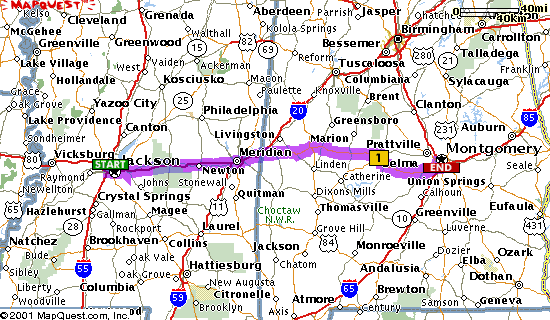
Get On the Bus 2002: Day 5
-
Meeting with Hollis Watkins, 10am at "Southern Echo:
in Jackson, MS. (Watkins was one of the first teenagers
in MS to join the SNCC voter registration project,
joining with Bob Moses in 1961.)
- Drive from Jackson, MS to Selma AL, and on to
Montgomery - 246 miles
- Meeting with Lawrence Huggins, Jimmy Webb, Lynda Lowery
and Joanne Bland, participants in the Selma-to-Montgomery
marches (1965) at the National Voting Rights Museum at
4pm.
Message
from Joe Gonzalez, trip leader:
Today
offered no respite from the unseasonable cold. For our
first appointment, we met with Hollis Watkins, who joined
Bob Moses's organizing efforts in the Mississippi Delta
as a teenager, and endured a stint in Parchman for his
efforts. Mr. Watkins now directs Southern Echo, an
organization devoted to promoting intergenerational
leadership in Jackson, Mississippi. After talking to (and
singing with) Mr. Watkins, we drove four hours to the
National Voting Rights Institute and Museum in Selma,
Alabama. In Selma, former activists Joanne Bland and Dr.
James Webb described their role in the Selma Movement and
Bloody Sunday. The evening found us in Montgomery, poised
for a tour of Montgomery and Birmingham.
Hollis
Watkins
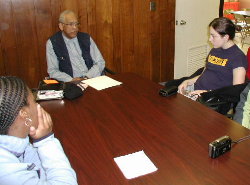
The
group speaks with Hollis Watkins.
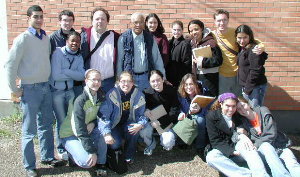
A
group photo with Hollis Watkins outside Southern Echo.
An excerpt of Rosa Osorio's journal about Hollis
Watkins:
. . . He
currently works on his new project of Southern Echo,
which helps groups, both old and young learn necessary
leadership and organizational skills. This is a way to
further the growth of the community in his area.
When asked about SNCC and SCLC he stated that he saw that
in locations where SNCC=young and SCLC=old worked
together, the progress in the community would go smoother
and quicker in contrast to where SNCC and SCLC would not
be cooperative with each other. Hollis Watkins advocated
the necessary cooperation between the young and old
groups because then everyone would be working toward a
common goal.
He also said that older people are scared of change and
of moving too fast so they don't allow young people to
keep moving forward. They stop any progress! So maybe I
think that the youth should try to help adults understand
their goals instead of getting frustrated and closing off
to the adults! (Although Watkins said that sometimes that
is necessary to bring about active results.)
He also sang freedom songs with us, which were very
inspiring. The actual singing of them was amazing and
allowed us to experience a little of what kept the people
motivated throughout the hard times in the 60s. ...
Excerpt
of Sarah Stewart's journal about visitng Hollis Watkins:
. . . Another big day for us. We started off with a
little confusion (note the little) as to how to get to
Hollis Watkins office. It's set in a neighborhood in a
not so nice part of Jackson. I was amazed when we were
driving down the street as to how little the houses are.
Right next door the house, a shotgun house by any
standards, was burn almost all the way to the ground. A
shell remained-like chars of wood that refuse to fall.
Even the houses that were intact reminded me (oddly
enough) of the student ghetto. The houses with couches
and chairs on the porch that have sat through years of
rain and landlords that couldn't give a damn as to
whether or not your house has paint on all the exterior.
The difference was that the student ghetto houses are
big, old houses that people had turned into renters.
These houses were rented most likely, but they were
people's homes. Four, five, or six people probably lived
in these little houses that are smaller even than my own.
(I live in a two bedroom, one bath house.) . . .
The National Voting Rights Museum
in Selma Alabama
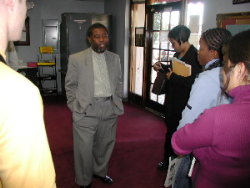
We
speak with former SNCC activist Dr. James Webb.

Fatima
and Regina
at the National Voting Rights Museum.
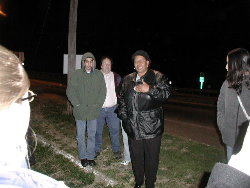
Joanne
Bland, a participant in the attempted March to Montgomery
known as Bloody Sunday in 1965.
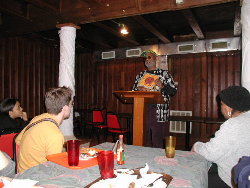
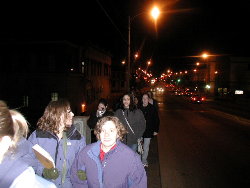
Crossing
the bridge in Selma, Alabama.
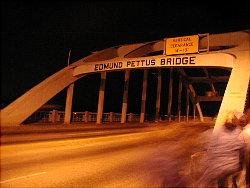
The Edmund
Pettus Bridge.
Excerpt
from Steph Fitzwater's journal:
.
. . Afterwards, we're back to the museum to organize to
march across the Edmund Pettus Bridge. Aly and I are
Hosea Williams and John Lewis as we lead our group
across. To look down beneath the bridge and see the river
that so many were frightened of having to escape into in
1965 because they could not swim, to see that which is
located on the other side of the bridge slowly coming
into view, to imagine an army of state troopers in riot
gear and on horses, simply to remember . . . I keep
thinking, "Someone was beaten here," or,
"Someone was trampled here." The thoughts are
mind-blowing. With the sights, location, and freedom
songs, the whole experience is very emotional. . . .
Excerpt from Sarah Alloy's journal:
.
. . When we arrive in Selma, we go to the Voting Rights
Museum. I was here a little over a year ago, but did not
have the opportunity to go inside as they were closed at
the time. I am very excited about this, for my family is
from Selma (and surrounding areas).
In Selma, I
feel my legacy, my history, more so than anywhere else on
this trip. My ancestors walked down these streets, looked
in the windows of these stores. They drank at the
inferior fountains, and deferred their places on the
sidewalk. They tasted the sting of segregation, and now,
I am standing here, entering a building they could only
dream of entering, with a group of people diverse beyond
her wildest youthful imagination. Today is a good day. .
. .
Excerpt from Amine Tourki's journal:
.
. . Hollis Watkins is the man of the trip. He knows what
he is talking about! And he gives down to earth advice on
how to change a community. I love the fact that he sang
with us. It was wonderful. Southern Echo is a model
organization that must be copied by every serious
organization on the globe. It is humble looking, yet
there's so much going on inside. I like the fact that he
trains activist, then send them on their merry way to
their communities. I was impressed by how he connected
environment, to sharecropping, to corporate America, to
the poverty, to civil rights. This is a man who can see
things that are around the block for what they really
are.
After seeing the national rights museum with the help of
Jimmy Webb and Joanne Bland. Joanne invited us to dinner,
and called shotgun so she rode next to Libby on our way
to the restaurant. There we talked to Jimmy Webb and her
about the movement.
Jimmy Webb was enthusiastic. I enjoyed hearing how he
almost got everyone killed during a demonstration. But I
also liked the analogy he made about his quarter being
equal to a white man's quarter. He did not answer my
question about Malcolm X, and him seeing the economic
disparities as the basis of all evil, not only political
rights. He said that King Senior used to stop by his
father's house. His father was a pastor too. His house
was a major stop, for the pastors (businessmen?) who
needed a place to sleep, while traveling, because there
were no black motels.
It seems that, in order for you to be recognized and to
move on up high, you need to have well connected family.
[ a reason why Margaret Block does
not seem to be doing well] There was definitely an elite
fraternity within the black society of those times.
I liked her story about how Jimmy was going to get them
killed. And how she fainted when she saw so much blood
during the crossing of the bridge.
Thus, crossing of the bridge was the thing to do after
dinner. It was cold outside, very cold. And I enjoyed
getting in the warm car afterwards.
|









